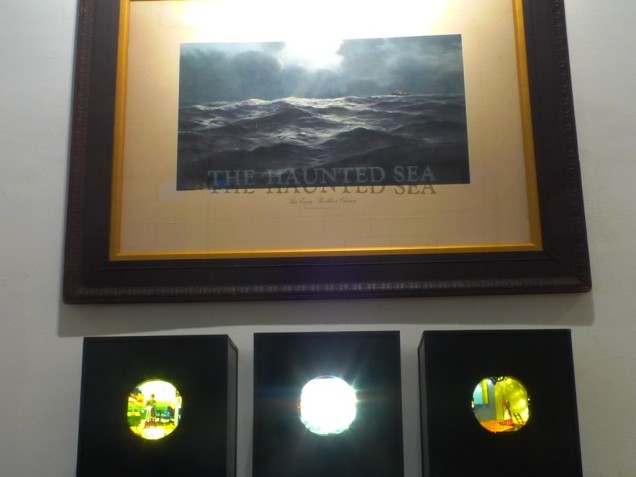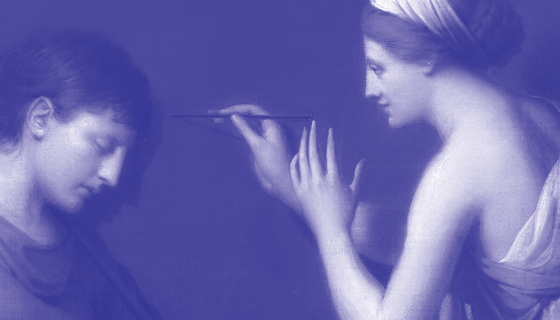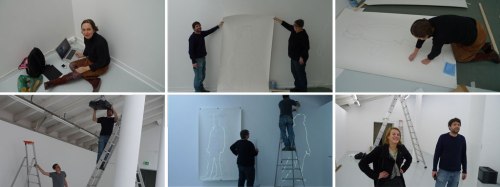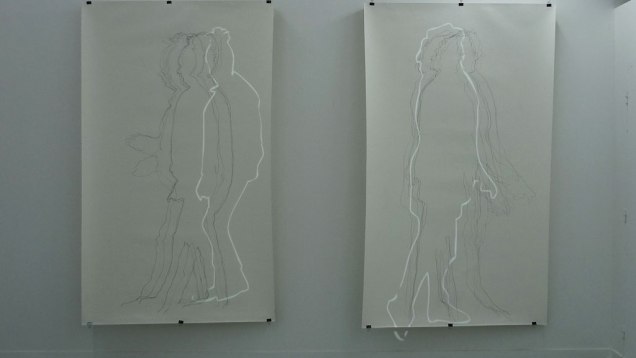Foá + Hosea, Carali McCall, Anne Robinson, Sarah Sparkes, Thurle Wright
Folkstone Triennial Fringe 29-31st August 2014
Deptford X 27th September – 5th October 2014


Curated by Birgitta Hosea
He will not have been (a) present but he will have made a gift by not disappearing without leaving a trace.
(Jacques Derrida in Re-Reading Levinas,1991)
Seeafar features new work by six artists whose practice traces the presence of absence through drawing, painting, installation, performance and moving image. Recalling the perspective of generations of women living in a state of unknowing as they wait for news or the return of loved ones from overseas, the works explore the tensions between anticipation and memory, separation and speculation. The visionary act of making becomes an empowering process that enables each one of us to think things into the world, to reveal the hidden and make manifest the unsaid.
The Old Truckers Lounge, Folkestone Harbour



Foá + Hosea
Traion III (Folkestone), Mixed Media (Graphite/pen on paper, projected animation), Dimensions variable (2014)
In the Traion series, Foá + Hosea respond to the myth of the first drawing, in which Butades’s daughter traced the outline of her lover’s shadow on the wall to hold on to his memory before he left on a journey. Foá + Hosea engage with this dilemma – the impossibility of attempting to hold time – through fixing their digital shadows in place with animation. In the title of the series, the words ‘trace’ and ‘motion’ are merged to reference their process of drawing over film, in which evidence of presence and motion is traced.
Artists’ bio: Maryclare Foá draws to examine the relationship and affects between place and practitioner. Her PhD revealed how sound can be drawing that interacts with the environment. She teaches for Central Saint Martins and writes for Studio International. Birgitta Hosea is a media artist working with expanded animation, installation and performance. Her work and PhD explore performativity, presence, affect and digital materiality. She is Course Director of MA Character Animation at CSM. Both artists have exhibited internationally and awards include Foá – RCA Drawing prize and twice shortlisted for the Jerwood Drawing Prize and Hosea – MAMA Holographic Arts Award and an Adobe Impact Award. Foá and Hosea work individually and also collaborate. Recent collaborative works have been exhibited in Paris – Dans ma cellule, une silhouette, Centre d’Art Contemporain, La Ferme du Buisson; London – Draw to Perform, ]Performance Space[; DRAFT, Parasol Unit; Bletchley Park – Ghost Station and Orkney – Papay Gyro Nights.
www.maryclarefoa.com
www.birgittahosea.co.uk




Carali McCall
Work no. 4 (Restraint / Running) Folkestone, Performance to camera (2014)
In an area of performance drawing, which considers drawing to be connected to movement through the act of doing and physical activity, this performance addresses what it means to use the extreme form of physical activity – running. Using (myself) the runner to articulate an understanding of how the body moves through space, I use the ‘breath’ and the discipline of marathon training to explore how the physical act of running can be a viable form of drawing.
Artist’s bio: Carali McCall is an artist working and living in London from Canada. She completed her MFA at Slade School of Art, UCL in 2006 and has recently submitted her practice-based PhD thesis at Central Saint Martins, UAL. Although training for marathons and ultramarathons have always occurred alongside her art practice, it was not until she adopted Euclid’s definition of the line ‘a line is a breadthless length’ and began to explore the role of the body in drawing that McCall has become aware of potential connections between running and drawing. Since studying the influences and the trajectory of performance art practices, her recent work has been used to explore linear properties beyond conventional mark making processes. Recent exhibitions and presentations of work include, Performing Site, Falmouth University 2014, Draw to Perform, Performance Space, London, 2013 and Again and Again and Again: Serial Formats and Repetitive Actions, Vancouver Art Gallery, Canada, 2012.
www.caralimccall.org




Anne Robinson
Skinny White Sailor, 4-6 x paintings, 30.5cm x 40.5cm, oil on canvas (2014)
Thrashing In the Static, Single screen video, 10 minute loop (2014)
How far is too far? How can we look over the edge, feel our way beyond the horizon, traverse time zones and cross the bounds of one human life? The two new works presented here, paintings in the series Skinny White Sailor and the song-film Thrashing In the Static, involve a haunting – keeping watch in the night for revenant sailors. In Robinson’s song-films the voice becomes spirit presence. In Thrashing In the Static, the wavelengths of a search for a brother lost at sea soar over the edge across time zones – a ‘traveling eye’ crossing from the Thames foreshore in 21st century London, way back to an island in the South China Sea in 1942, a dream terrain, long away and far ago. The work draws on surrealism, phenomenology and radical philosophies of time to work with uncanny presence, the sorcery of long exposures, high speed filming and painterly surface distorting out time sense.
Artist’s bio: Anne Robinson’s practice encompasses painting, moving image installations and performance and is concerned with the perception and politics of time passing in art. She has shown work nationally and internationally, recently working with the Commonist Gallery and CGTV on film and singing interventions. She completed a residency in 2013 in Marseilles at De Centre der Space. She has published in: The Journal of Visual Arts Practice and The Journal of Media Practice as well as curating One More Time (2011), Over Time (2014) and being one of the art curators for the Supernormal festival. She has recently completed a PhD on temporality and painting and also works with the moving image in collaboration with other artists and as an educator, currently senior lecturer in Film at London Metropolitan University.
annerobinsonartwork.org




Sarah Sparkes
The Haunted Sea and Jane Conquest Rings the Bell, Mixed media (2014)
Sarah Sparkes’ great grandfather was a Magic Lanternist. Using his decaying lantern slides and combining these with a magician’s optical effects, the artist has created a series of works illuminating the ambiguous relationship between the woman watching on the shore and the spectre of the shipwreck at sea. In Jane Conquest rings the Bell a standard maritime narrative is re-imagined, in which a visionary woman looks out from behind the helm of destiny.
Artist’s bio: Sarah Sparkes’ work, as both an artist and curator, is primarily concerned with concepts of immateriality and how this might be visualised. She runs the visual arts and cross-disciplinary research project GHost, which explores how ghosts are manifested in visual art and contemporary culture. Her chapter on Ghost has been published in The Ashgate Research Companion to Paranormal Cultures, 2014. Recent exhibitions include Theatrical Dynamics at Torrance Art Museum, Los Angeles; The Infinity Show at NN Contemporary, Northampton and Haunted Landscapes, University of Falmouth, Cornwall. She is currently developing work for the Over Time project in Greenwich, London and is one of the selected artists for Art in Romney Marsh Churches, 2014.
www.sarahsparkes.com




Thurle Wright
Crossing, Collage (Found map of Dover Strait and two poems by Matthew Arnold; ‘Dover Beach’ and ‘Calais Sands’), 90x100cm, (2012)
Deep Reading (Extract from children’s adventure novel and old school atlas, glue, on paper), 60 x 20″, (2010)
An oily old sea map and pages from a poetry book: the poems in this work are addressed to a woman at the end of her honeymoon travels. The poet, Arnold, speaks to his new wife as he gazes out to sea at night contemplating the future in a mood of great uncertainty and melancholy. In deconstructing the lines of the poems and stitching them in small paper stages across the map, the physical progress of the sea crossing is referenced, flowing alongside the slow unravelling process of reflecting and writing itself. There is a patient stitching of thoughts, not knowing how it will end. The words themselves become waves and currents, caught in that space between leaving and arriving, at the mercy of the tides.
Artist’s Bio: Thurle’s delicate paper reconstructions stem from an interest in the systems and structures of language, the ordering of knowledge, the collecting, storing and accessing of words. Working in the gap between the concrete and abstract impression of text on paper, Thurle cuts, folds, weaves and stitches lines of words into a new visual format, in which traces of the original mingle with personal, often playful or poetic interpretations. Thurle has shown work widely both in the UK and internationally including the Bookarts Triennial in Lithuania, Deptford X, and Brussels Art on Paper. Her work is in various public and private collections including Brisbane Sate Library. Numerous residencies include work for the V&A Museum of Childhood, Perth Central School of Art and Design, Fremantle Arts Centre, Camberwell Arts Festival and various colleges.
www.thurle.com



 Bonus artwork by Sandra Louison at Folkestone
Bonus artwork by Sandra Louison at Folkestone


Num3er, Creekside, Deptford



Acknowledgements: thanks to all of the artists for their help in putting together this exhibition as well as Anne Pietsch, Sandra Louison and the teams behind the Folkestone Fringe, Num3er and Deptford X







































